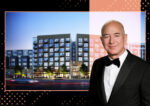Developers in Seattle must calculate a bigger inflation premium for construction than anywhere in the country.
Construction costs in Seattle jumped 7.76 percent in October from a year earlier, the Puget Sound Business Journal reported, citing a fourth quarter construction cost report from Rider Levett Bucknall. During the same period, national construction costs 5.9 percent.
The Pacific Northwest city led the nation in increased construction costs, followed by Chicago, Portland, Boston and New York.
Builders in any U.S. city must grapple with a higher borrowing cost and higher costs for materials driven by inflation.

But in Seattle, developers must grapple with some of the highest wages in the country, according to Kevin Mitchell, a vice president at RLB, who oversees the Pacific Northwest.
“Obviously, we need workers to get the work done,” Mitchell told the Business Journal. “So that’s certainly one of the elements that drives up the cost of doing work.”
The average U.S. construction worker makes $28.08 an hour, according to the U.S. Bureau of Labor Statistics. In Seattle, the average hard hat earns $37.58 per hour.
The rising cost of building has impacted projects across the Puget Sound, most recently at the 19-acre Gardens District development in Woodinville, according to the Business Journal. Green Partners, backed by Bill Gates, hit pause on the project late last year.
Despite rising costs, most developers forge ahead.
Seattle had 45 projects underway, the highest among the 13 North American markets surveyed. Mitchell of RLB said 36 of the 45 cranes he counted in Seattle were new developments, which suggests confidence in the market.
More than 6 million square feet of new offices are under construction, according to the newspaper, despite office landlords struggling to find tenants.
The price of building a prime, high-end office building in Seattle is $610 per square foot, according to the RLB report.
“If you’re going to build it, it’s going to cost you,” Mitchell told the Business Times. “You’ve got to decide whether there’s a market for that expensive product or not.”
— Dana Bartholomew
Read more



